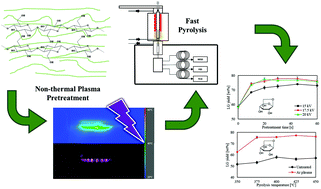当前位置:
X-MOL 学术
›
Green Chem.
›
论文详情
Our official English website, www.x-mol.net, welcomes your
feedback! (Note: you will need to create a separate account there.)
Producing high yield of levoglucosan by pyrolyzing nonthermal plasma-pretreated cellulose
Green Chemistry ( IF 9.3 ) Pub Date : 2020/02/28 , DOI: 10.1039/d0gc00255k Lusi A 1, 2, 3, 4 , Haiyang Hu 2, 3, 4, 5 , Xianglan Bai 1, 2, 3, 4
Green Chemistry ( IF 9.3 ) Pub Date : 2020/02/28 , DOI: 10.1039/d0gc00255k Lusi A 1, 2, 3, 4 , Haiyang Hu 2, 3, 4, 5 , Xianglan Bai 1, 2, 3, 4
Affiliation

|
Atmospheric pressure nonthermal plasma treatment can be a novel, green and low energy method to convert biomass to biobased chemicals. The unique physiochemistry of plasma discharge enables reactions within biomass that otherwise could not possibly occur under traditional conditions. In this study, we present a simple method of producing a high yield of levoglucosan from cellulose without using any catalysts, chemicals, solvents or vacuum, but by using plasma treatment to control the depolymerization mechanism of cellulose. Cellulose was first pretreated in a dielectric barrier discharge reactor operating in ambient air or argon for 10–60 s, followed by pyrolysis at 350–450 °C to produce up to 78.6% of levoglucosan. Without the plasma pretreatment, the maximum yield of levoglucosan from cellulose pyrolysis was 58.2%. The results of this study showed that the plasma pretreatment led to homolytic cleavage of glycosidic bonds. The resulting free radicals were then trapped within the cellulose structure when the plasma discharge stopped, allowing subsequent pyrolysis of the plasma-pretreated cellulose to proceed through a radical-based mechanism. The present results also revealed that although the radical-based mechanism is highly selective to levoglucosan formation, this pathway is usually discouraged when the untreated cellulose is pyrolyzed due to the high energy barrier for homolytic cleavage. Initiating homolytic cleavage during the plasma pretreatment also helped the pretreated cellulose to produce higher yields of levoglucosan using lower pyrolysis temperatures. At 375 °C, the levoglucosan yield was only 53.2% for the untreated cellulose, whereas the yield reached 77.6% for the argon-plasma pretreated cellulose.
中文翻译:

通过热解等离子预处理的纤维素生产高产率的左旋葡聚糖
大气压非热等离子体处理可以是一种新颖,绿色,低能耗的方法,可以将生物质转化为生物基化学物质。等离子体放电的独特生理化学特性使生物质内的反应在传统条件下不可能发生。在这项研究中,我们提出了一种简单的方法,无需使用任何催化剂,化学药品,溶剂或真空,而是通过等离子体处理来控制纤维素的解聚机理,从而可以从纤维素生产高产率的左旋葡聚糖。首先在环境空气或氩气中的介电屏障放电反应器中对纤维素进行10–60 s的预处理,然后在350–450°C的温度下热解以生产出高达78.6%的左旋葡聚糖。如果不进行血浆预处理,则纤维素热解的左旋葡聚糖的最大产率为58.2%。这项研究的结果表明,血浆预处理导致糖苷键的均质裂解。然后,当等离子放电停止时,所产生的自由基被捕集在纤维素结构内,从而允许等离子预处理的纤维素的后续热解通过基于自由基的机理进行。目前的结果还表明,尽管基于自由基的机制对左旋葡聚糖的形成具有很高的选择性,但是由于未经裂解的纤维素因均质裂解的高能垒而被热解时,通常不鼓励采用这种途径。在等离子体预处理期间开始均质裂解也有助于预处理的纤维素在较低的热解温度下产生较高产率的左旋葡聚糖。在375°C下,未经处理的纤维素的左旋葡聚糖产率仅为53.2%,
更新日期:2020-03-24
中文翻译:

通过热解等离子预处理的纤维素生产高产率的左旋葡聚糖
大气压非热等离子体处理可以是一种新颖,绿色,低能耗的方法,可以将生物质转化为生物基化学物质。等离子体放电的独特生理化学特性使生物质内的反应在传统条件下不可能发生。在这项研究中,我们提出了一种简单的方法,无需使用任何催化剂,化学药品,溶剂或真空,而是通过等离子体处理来控制纤维素的解聚机理,从而可以从纤维素生产高产率的左旋葡聚糖。首先在环境空气或氩气中的介电屏障放电反应器中对纤维素进行10–60 s的预处理,然后在350–450°C的温度下热解以生产出高达78.6%的左旋葡聚糖。如果不进行血浆预处理,则纤维素热解的左旋葡聚糖的最大产率为58.2%。这项研究的结果表明,血浆预处理导致糖苷键的均质裂解。然后,当等离子放电停止时,所产生的自由基被捕集在纤维素结构内,从而允许等离子预处理的纤维素的后续热解通过基于自由基的机理进行。目前的结果还表明,尽管基于自由基的机制对左旋葡聚糖的形成具有很高的选择性,但是由于未经裂解的纤维素因均质裂解的高能垒而被热解时,通常不鼓励采用这种途径。在等离子体预处理期间开始均质裂解也有助于预处理的纤维素在较低的热解温度下产生较高产率的左旋葡聚糖。在375°C下,未经处理的纤维素的左旋葡聚糖产率仅为53.2%,











































 京公网安备 11010802027423号
京公网安备 11010802027423号